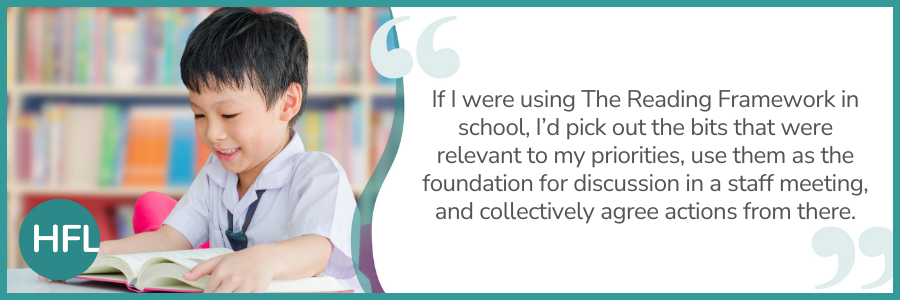
In July 2023, the DfE released an update to The Reading Framework. It’s a rather hefty document at 171 pages. Luckily, it builds on the original 2021 document with some useful guidance on many aspects of reading within schools into key stage 2 and beyond. It may also leave you with questions on how to approach the vital yet complex task of teaching all pupils to read.
Throughout the framework, there are useful audits which are designed to help leaders and staff reflect on practice in your setting. These will be helpful when evaluating provision and planning next steps, however they cannot all be used at once. Choosing one or two key priorities at a time will help to affect more sustainable change. I won’t attempt to cover the whole document in a single blog – at risk of producing another 100+ page document - so instead I’ll reflect on the messages in some sections of the guidance, and present further food for thought to support discussion among colleagues.
If I were using The Reading Framework in school, I’d pick out the bits that were relevant to my priorities, use them as the foundation for discussion in a staff meeting, and collectively agree actions from there. In this blog, I’ve done a little of that, reflecting briefly on some of the messages, and posing questions to support reflection and discussion.
Let’s dive in.
Section 1: The importance of reading and a conceptual model (p. 10-20)
In this opening section we are presented with the conceptual model ‘The Simple View of Reading’ from Gough and Tunmer, which presents two dimensions of reading: word reading and language comprehension. The Primary National Curriculum is aligned to this model, however teachers may benefit from a deeper understanding of what these two dimensions mean in practice.
Other conceptual models for reading help to flesh out the ideas within ‘The Simple View of Reading’, providing useful guidance for teachers when considering what needs to be taught (and how) and where gaps may arise in pupils’ learning. These models outline the intricacies of what it takes to be a proficient reader, knowledge which is fundamental to teaching reading effectively. Both build upon ‘The Simple View of Reading’ by breaking down language comprehension and word recognition into their component parts.
Scarborough’s Reading Rope provides the useful metaphor of a rope, with each strand of word reading (e.g. phonological awareness, decoding, etc) and language comprehension (e.g. vocabulary, background knowledge, etc) being woven together leading to a strong ‘rope’ of skilled reading.
The EEF’s Reading House is a similarly valuable model, and their website provides guidance for each ‘room’ of the house plus plenty of wider reading to develop subject knowledge.
Questions to consider:
Are staff familiar with a conceptual model for reading?
How might you be able to build staff subject knowledge using a model?
How could this model underpin successful teaching of reading across the age range?
Section 4: Developing fluency (p. 60-65)
Guidance on reading fluency is a welcome addition to The Reading Framework update. Within the document, the need for accuracy in reading is widely acknowledged, and much guidance is offered on the teaching of phonics and spelling in section three.
When talking about fluency, the document attempts to avoid conflation of reading fluency with simply reading quickly. This is key. No doubt, you can think of readers who race through the text to reach the end, but struggle to understand what they have read. They may sound okay to listen to so slip under the radar when it comes to intervention. These readers may simply be focused on lifting the words from the page, rather than making meaning of them (the real goal of reading). Conversely, you’ll be able to think of children whose decoding is slow and laboured meaning that they have lost track of the beginning of the sentence by the time they get to the end of it.
Understanding the text is challenging if cognitive space is overloaded with decoding; this is why both accuracy and automaticity are fundamental to fluency. Prosody – the third strand of reading fluency – is barely mentioned in the framework. Application of prosody at the point of reading allows for a ‘meaning-laden’ read, which provides a good foundation for comprehension to flourish. If you’re keen to develop your understanding of prosody, then do read my recent article ‘Prosody in reading – how to teach it in primary’.
While dysfluent readers will require more intensive support (such as The Reading Fluency Project), all children will benefit from some regular fluency instruction. Take a look at the document we created in collaboration with the EEF - ‘What might fluency practice look like in the classroom?’ – to consider how you might weave this throughout your day.
Questions to consider:
How do you identify and support dysfluent readers?
Do all children get the opportunity to practise reading within their reading lessons?
How is reading fluency developed in reading lessons?
What opportunities are there across your curriculum for children to develop fluency?
Section 5: Pupils who need the most support (p. 66-80)
The need for strong assessment procedures to swiftly identify pupils who are falling behind their peers is a theme within this section. It is vital that staff know what the ‘milestones’ of your SSP programme are, and what success looks like at each of those. Early identification of children who are not keeping up with the pace of the programme will ensure that they receive the targeted support and extra practice they need.
Kirsten Snook discussed principles for accurate assessment of early reading in her blog: A tale of two biggies: the A’s of early reading – closing the gaps for disadvantaged children - Part 1. She went on to discuss application opportunities for pupils who need the most support in her other blog: A tale of two biggies: the A’s of early reading – closing the gaps for disadvantaged children - Part 2 which explores how that ‘just right’ application and practise helps to motivate struggling early readers and accelerate their progress. Understanding other elements of what makes a skilled reader (see the conceptual models) will help to identify where pupils’ gaps lie (e.g. vocabulary, comprehension monitoring, fluency) and to target specific instruction within the classroom and in interventions.
The Reading Framework offers further guidance on how to support older pupils who need to catch up, again making clear that schools must identify pupils’ specific gaps through careful and frequent assessment (e.g. does the child need support in decoding or fluency? Which GPCs are they missing? Can they recognise the graphemes on flashcards? How do they apply this knowledge when blending? What about at text level? etc). Teachers should use this knowledge to ensure pupils enter interventions at the ‘just right’ point of the programme to avoid starting from the very beginning or leaving gaps unfilled.
The Reading Framework advocates daily support from well-trained staff to accelerate progress; this should be timetabled and managed by leaders so that pupils receive sufficient support to catch up, even if this means missing other lessons. The guidance makes it clear that learning to read must be prioritised, and guidance on managing this is offered under ‘Organising and teaching catch up’ on page 75.
Questions to consider:
Are all staff clear on the ‘milestones’ in the school’s chosen SSP?
Can staff confidently assess pupils’ application of phonic knowledge?
Is reading intervention targeted to pupils’ specific needs?
Is daily reading ‘catch-up’ prioritised to accelerate progress?
Section 10: Teaching reading in the English lesson (p. 107-119)
This section is particularly useful when thinking about enhancing reading lessons. I was glad to see that there is significant emphasis placed on reading for enjoyment and discovery within this segment of The Reading Framework: “Through the books and poems they encounter, through the characters and situations that they meet, and the discussion that surrounds the text, pupils have a chance to experience the excitement, wonder and fascination that can come from reading, to feel what it is like to lose themselves in a story.” (p. 107, The Reading Framework). Ellen Counter explored effective guided reading teaching in her blog: Whole class guided reading in KS2: Finding the right balance for all children (Part 1), with careful consideration of how to make it work for all pupils.
Putting thought and discussion at the heart of teaching reading will help pupils to develop authentic interest in the texts we share. Questioning within lessons should allow children to deepen, develop and organise their ideas, rather than simply testing what they already know. It is important to distinguish between questioning for assessment and questioning to develop thinking; staff should know how, when and why to use each.
The guidance is clear: comprehension is an outcome, not a skill to practise, so we should not need to teach the testing domains in isolation, (i.e. focus for one lesson on summary, then prediction and then inference) or allow these to become our school reading curriculum. Instead, we should teach these holistically, in the way which we would apply them when reading ourselves. Comprehension and inference grow from application of all of these elements, as demonstrated in our HFL model for reading comprehension. If you have questions about how this could work in Year 6, with SATs in mind, then section 11 provides further detail and this blog from Kayleigh Valentini and Rickella Griffiths will be useful too: Reading SATs knowledge; Reading SATs power.
The Reading Framework explains that teachers should demonstrate to pupils how they construct ‘mental models’ when developing their understanding of a text. This modelling is fundamental to effective reading instruction; we would always model in writing or in maths and should do so in reading too. Reading can appear rather mystical to struggling readers, as so much of what we do as skilled readers happens in our heads. It is vital that we demystify the process of reading comprehension by speaking aloud how we construct our ideas and understanding of what we read through explanation, modelling and support.
Questions to consider:
How do teachers use modelling as a teaching tool within reading lessons?
How can we support all children to participate in class discussions about the texts we read?
Do the questions we ask support children to develop their thinking, or simply test what they know already?
There’s a lot to digest in the updated Reading Framework. It certainly doesn’t answer all questions, but it does offer some useful food for thought. We’ve only scratched the surface in this blog.
Don’t hesitate to get in touch or speak to your Teaching and Learning Adviser if you want to explore the messages in The Reading Framework any further.
We discussed the implications of The Reading Framework in greater detail at the first of this year’s ‘Leading Primary English in Current Times’ webinars. If you would like to purchase the recording of that session, or sign up to join us at the next webinar which will focus on effective writing curriculums.



